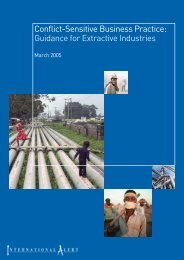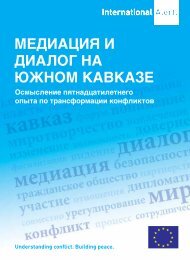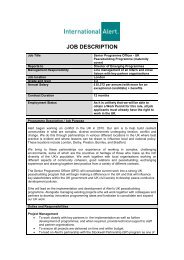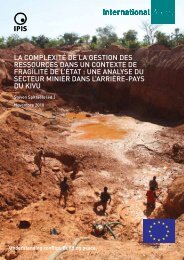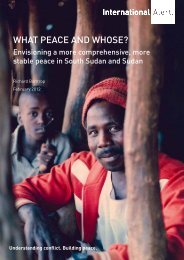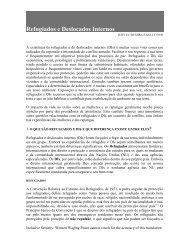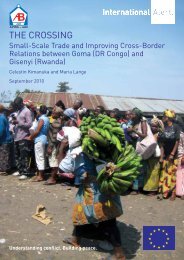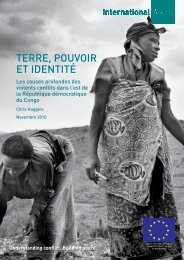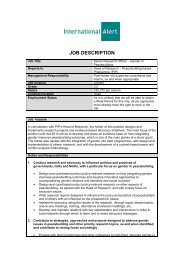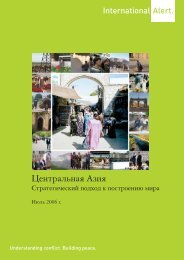The complexiTy of resource governance in a conTexT of sTaTe ... - Ipis
The complexiTy of resource governance in a conTexT of sTaTe ... - Ipis
The complexiTy of resource governance in a conTexT of sTaTe ... - Ipis
You also want an ePaper? Increase the reach of your titles
YUMPU automatically turns print PDFs into web optimized ePapers that Google loves.
<strong>The</strong> complexity <strong>of</strong> <strong>resource</strong> <strong>governance</strong> <strong>in</strong> a context <strong>of</strong> state fragility: An analysis <strong>of</strong> the m<strong>in</strong><strong>in</strong>g sector <strong>in</strong> the Kivu h<strong>in</strong>terlands<br />
37<br />
2.4 Presence <strong>of</strong> armed groups and human rights violations<br />
<strong>The</strong> security situation <strong>in</strong> Maniema prov<strong>in</strong>ce is calm <strong>in</strong> comparison to the Kivu prov<strong>in</strong>ces. In<br />
three territories (Lubutu, Punia and Kabambare), however, there are reports <strong>of</strong> rebel <strong>in</strong>cursions,<br />
extortion and armed confrontations, notably <strong>in</strong> eastern sectors near the Kivu border. Furthermore,<br />
community conflicts over land exist <strong>in</strong> other territories, for example Pangi and Kailo. 129 Although<br />
the general security situation is calm, and <strong>in</strong> spite <strong>of</strong> the existence <strong>of</strong> m<strong>in</strong><strong>in</strong>g areas where m<strong>in</strong>eral<br />
exploitation seems to be free from militarisation, natural <strong>resource</strong>s represent a motivat<strong>in</strong>g factor<br />
for armed groups <strong>in</strong> Maniema.<br />
In the paragraphs below, a few cases illustrat<strong>in</strong>g <strong>in</strong>volvement <strong>in</strong> Maniema’s m<strong>in</strong><strong>in</strong>g sector by<br />
armed units – <strong>in</strong>clud<strong>in</strong>g both rebel groups and FARDC – will be discussed. <strong>The</strong>se cases are not<br />
an exhaustive list <strong>of</strong> the prov<strong>in</strong>ce’s militarised m<strong>in</strong><strong>in</strong>g zones, but are some strik<strong>in</strong>g examples that<br />
help to illum<strong>in</strong>ate the problem. 130<br />
Kasese<br />
Kasese is located <strong>in</strong> the centre <strong>of</strong> Babira Bakwame sector, Punia territory, an area well-known<br />
for its cassiterite production. Kasese used to be an important rice and palm-oil producer, but<br />
agricultural activities have ceased and have been replaced by artisanal m<strong>in</strong><strong>in</strong>g. 131 Nowadays, all<br />
provisions have to be imported from the Kivu prov<strong>in</strong>ces. S<strong>in</strong>ce the sector can only be reached on<br />
foot or by plane, these are flown <strong>in</strong>.<br />
Access to Kasese’s natural <strong>resource</strong>s is an important factor fuell<strong>in</strong>g local conflict and has resulted<br />
<strong>in</strong> a number <strong>of</strong> security <strong>in</strong>cidents. Local conflict derives from ethnic tension between the BaKwame<br />
and BaBira peoples. <strong>The</strong> BaKwame are a m<strong>in</strong>ority group which is well-represented <strong>in</strong> two <strong>of</strong> the<br />
sector’s six collectivities, <strong>in</strong>clud<strong>in</strong>g Kasese town, where they constitute the majority. BaKwame are<br />
considered the customary holders <strong>of</strong> land titles, while the BaBira, on the other hand, are seen as<br />
newcomers even though they constitute the majority <strong>in</strong> the sector as a whole. <strong>The</strong>y also have the<br />
most adm<strong>in</strong>istrative power, and consequently have more <strong>in</strong>fluence on the distribution <strong>of</strong> m<strong>in</strong><strong>in</strong>g<br />
titles. This is a significant source <strong>of</strong> frustration for the BaKwame, who see it as an <strong>in</strong>fr<strong>in</strong>gement<br />
<strong>of</strong> their traditional rights. This discord could be exploited by armed factions present <strong>in</strong> the area.<br />
It must be emphasised that the presence <strong>of</strong> armed groups concerns only <strong>in</strong>cursions, as they have no<br />
permanent bases <strong>in</strong> Babira Bakwame sector. <strong>The</strong> Mayi Mayi Simba, from Walikale territory – not<br />
to be confused with General Mando’s Mayi Mayi Simba who operate <strong>in</strong> Lubutu territory – are<br />
attracted by Kasese’s natural <strong>resource</strong>s and every few months there are confrontations between<br />
them and the FARDC. In July 2010, for example, the latter clashed with the Mayi Mayi Simba over<br />
the m<strong>in</strong><strong>in</strong>g sites <strong>of</strong> Pumuzika and Ujumo, west <strong>of</strong> Kasese, where the rebels tried to seize control. 132<br />
<strong>The</strong> FARDC, which is supposed to protect the population and consolidate security, <strong>of</strong>ten does the<br />
opposite. S<strong>in</strong>ce the Kimia II military operations, there is a larger FARDC presence and the soldiers<br />
regularly seek to ga<strong>in</strong> control <strong>of</strong> m<strong>in</strong><strong>in</strong>g sites and to loot from the local population. In May 2010,<br />
for example, FARDC elements under the command <strong>of</strong> Eric Malonga are said to have pillaged 400<br />
129 IPIS, unpublished UN Environmental Programme commissioned report 2010.<br />
130 IPIS, unpublished UN Environmental Programme commissioned report, 2010.<br />
131 <strong>The</strong> two consecutive Congolese wars have had a devastat<strong>in</strong>g effect on Maniema’s agricultural sector. Insecurity <strong>in</strong> the countryside caused<br />
a population movement towards the cities, lead<strong>in</strong>g to a loss <strong>of</strong> workforce. This was further re<strong>in</strong>forced when people turned to m<strong>in</strong>eral<br />
exploitation <strong>in</strong> the hope <strong>of</strong> mak<strong>in</strong>g rapid pr<strong>of</strong>its. Insecurity and poor road conditions stopped farmers who rema<strong>in</strong>ed <strong>in</strong> the country from<br />
reach<strong>in</strong>g the markets. Furthermore, there was a lack <strong>of</strong> adequate farm<strong>in</strong>g equipment, either because it was stolen or because it was<br />
abandoned by farmers when they fled. Most <strong>of</strong> these effects persist to the present day. Moreover, <strong>in</strong> those areas where m<strong>in</strong><strong>in</strong>g activity is<br />
boom<strong>in</strong>g, and because the m<strong>in</strong>eral wealth attracts immigrants, the demand for food (and agricultural products <strong>in</strong> general) rises at the<br />
same time as agricultural production decl<strong>in</strong>es, exacerbat<strong>in</strong>g shortages and push<strong>in</strong>g up prices. (Source: IPIS, unpublished United Nations<br />
Environmental Programme commissioned report, 2010.)<br />
132 Confidential written UN source.





